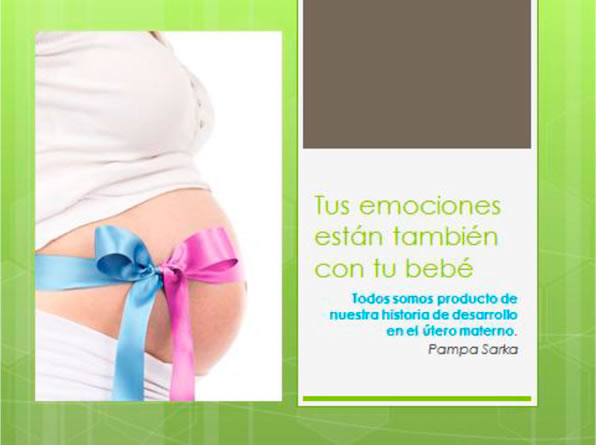
doi.org/10.15198/seeci.2018.46.93-115
RESEARCH
PARENTS’ PRENATAL SCHOOL. Where is the instructions booklet? (Intervention proposal with parents in the prenatal period, to improve their children’s comprehensive development)
ESCUELA PRENATAL DE PADRES Y MADRES. ¿Dónde está el libro de instrucciones? (Propuesta de intervención con padres y madres, en época prenatal, para la preparación al desarrollo integral de los hijos)
ESCOLA PRÉ PARTO DE PAIS E MÃES. Onde está o manual de instruções? (Proposta de intervenção com pais e mães, em época anterior ao parto, para a preparação ao desenvolvimento integral dos filhos)
Purificación Cruz-Cruz1
Alicia Sánchez-Baillo2
Álvaro Hidalgo-Robles2
1Profesora asociada de la Facultad de Educación de Toledo. Departamento de Pedagogía. Área de didáctica y organización escolar
2Universidad de Castilla-La Mancha
SUMMARY
Prenatal period happens to be an essential moment in which parents focus on their skills on how to educate the new member of the family in the best way. However, when the real parent’s time starts, they don’t know how to solve certain complex situations for which they haven’t been prepared. Daily situations which answer to the typical question “Where is the instructions booklet?” and respond to the affirmation “your life is going to change”. We want our children to enjoy a full and correct development. To achieve this objective it is essential to have a balance between aspects from the physical, behavioral and emotional areas. We should work as an effective and well-coordinated team. Prenatal period is the best time to do it. Thus, we can favor prevention, strengthen stimulation and support in doubt. With this work we intend to prove thate parents’ prenatal schools are a useful resource to guide families in their difficult task of teaching their children and being mother and father, learning how to educate another human being. In order to verify this hypothesis, we have conducted an intervention with a group of future parents who we convened through health services, and we have analyzed the results. The high interest that this has aroused and the general wish to keep in the process of education to learn how to teach are particularly outstanding.
KEY WORDS: prenatal period; parents’ school; comprehensive education; psychomotor development; emotional development.
RESUMEN
El periodo prenatal resulta ser el momento fundamental donde la pareja centra su atención en la preparación de cada uno de los aspectos relacionados con la llegada del nuevo miembro de la familia. Cuando llega el momento del nacimiento los padres se encuentran con situaciones complejas para las que no han sido preparados y que responden a la típica y cómica pregunta de ¿dónde está el libro de instrucciones?
Si pretendemos que nuestros hijos gocen de un correcto y completo desarrollo, debemos conseguir un equilibrio y una buena relación entre los aspectos de su equilibrio integral: físico, conductual y emocional, a través de un trabajo conjunto, coordinado y eficaz. El momento ideal para ese trabajo conjunto, para el desarrollo de esa preparación, es en el periodo prenatal. Así podemos favorecer la prevención, fortalecer la estimulación, y acompañar en la dubitación. A través de este trabajo se pretende demostrar que las escuelas de padres prenatales resultan un recurso muy útil para orientar y ayudar a las familias en el trabajo al que se tendrán que enfrentar, facilitándoles el día a día en esta ardua y compleja labor que resulta ser padre y madre. Para verificar dicha hipótesis hemos llevado a cabo una intervención con un grupos de parejas que esperan un bebé, convocados a través de servicios sanitarios, y analizados los resultados. Destacando, principalmente, el gran interés despertado y el deseo de seguir participando en el proceso de “educación para aprender a educar”
PALABRAS CLAVES: época prenatal; escuela de padres y madres; educación integral; desarrollo psicomotor; desarrollo emocional
RESUME
O período anterior ao parto resulta ser o momento fundamental onde o casal centra sua atenção na preparação de cada um dos aspectos relacionados com a chegada do novo membro da família. Quando chega o momento do nascimento os pais se encontram com situações complexas para as que não foram preparados e que respondem a típica e cômica pergunta: onde está o manual de instruções?. Se pretendemos que nossos filhos gozem de um correto e completo desenvolvimento, devemos conseguir um equilíbrio e uma boa relação entre os aspectos de seu equilíbrio integral: físico, de conduto e emocional, através de um trabalho em conjunto, coordenado e eficaz. O momento ideal para esse trabalho conjunto, para o desenvolvimento desta preparação, é no período anterior ao parto. Assim podemos favorecer a prevenção, fortalecer a estimulação, e acompanhar nas suas dúvidas. Através deste trabalho pretendemos demonstrar que as escolas de pais pré-natais resultam um recurso bastante útil para orientar e ajudar as famílias no trabalho que terão que enfrentar, facilitando seu dia a dia nesta árdua e complexa labor que é ser pai e mãe. Para verificar esta hipótese fizemos uma intervenção com um grupo de pais que esperam um bebe, convocados através dos serviços sociais e analisado os resultados. Destacando principalmente o grande interesse despertado e o desejo de seguir participando no processo de ¨educação para aprender a educar”.
PALAVRAS CHAVE: Época anterior ao parto; Escola de pais e mães; Educação integral; Desenvolvimento psicomotor; desenvolvimento emocional
Received: 17/03/2018
Accepted: 05/05/2018
Published: 15/07/2018
Correspondence: Purificación Cruz Cruz
Purificacion.Cruz@uclm.es
Alicia Sánchez Baillo
Alicia.Sanchez@uclm.es
Álvaro Hidalgo Robles
hidalgor@uclm.es
Cómo citar el artículo
Cruz Cruz, P.; Sánchez Baillo, A.; Hidalgo Robles, A. (2018). Parents’ prenatal school. Where is the instructions booklet? [Escuela prenatal de padres y madres. ¿Dónde está el libro de instrucciones?]
Revista de Comunicación de la SEECI, 46, 93-115
doi: http://doi.org/10.15198/seeci.2018.46.93-115
Recuperado de http://www.seeci.net/revista/index.php/seeci/article/view/504
1. INTRODUCTION. STATE OF THE ART: SCHOOL FOR FATHERS AND MOTHERS
The family is the first agent of socialization for children; therefore, it turns out to be a fundamental and basic pillar when it comes to achieving an integral development of the individual. However, many times parents are faced with problems in their day to day that they do not know how to face, or that they solve in the wrong way.
Juan José Brunet Gutiérrez and José Luis Negro Failde define School for Parents as “a systematic training plan for parents in the psychopedagogical and environmental aspects, which takes place over a relatively long period of time”. (Brunet Gutiérrez & Negro Faile, 1994)1
1J.J. Brunet, y Negro, J.L.: ¿Cómo organizar una escuela de padres? Ediciones San Pío X, Madrid, 1985, pp. 21-36.
Schools for Parents represent a great opportunity to establish a space for information and participation that provides an exchange on the attitudes and progress of children, and a mutual transmission of information about everyday events and how to act when faced with them.
Schools for parents are one of the most interesting strategies to create an educational dialogue about the aims and means of education: why we educate, how we educate. It is inserted in the area of ??communication or conversation, which does not attempt to achieve any short-term operational decision, but only reflection, dialogue, consensus” (De la Puente, 1999, p. 246)2
2Como surge la escuela de padres. http://www.buenastareas.com/ensayos/Esuela-Para-Padres/5780331.html
1.1. Origin
In the twentieth century, society began to be particularly concerned with the care of children, which is why it sees education as an essential educational aspect. To respond to these formative needs of society, schools for parents are created in the United States and France simultaneously. In 1929, under the motto: “Unite, instruct and serve”, Madame Vérine created in Paris the first school for parents the purpose of which was the interaction between people who cared about childhood education. This school was made up of educators, parents and specialists in the field of education and childhood.
Over time, schools for parents have been characterized by the organization of workshop-type talks on topics of interest to parents, directed by people who have prepared each topic.
1.2. Goals
According to the authors Juan José Brunet Gutiérrez and José Luis Negro Failde, there are three general and essential objectives when starting a School for Parents:
– “Serve as a channel for review and learning for parents on issues related to the education of their children”
– “Promote communication about the situations that are lived in the family, creating an atmosphere of friendship”
– “Increase the integration of parents, offering them specific fields of activity” (Brunet Gutiérrez & Negro Faile, 1994)3
However, these objectives are not the only ones that we can establish, and there may be many others that can even be proposed by the parents.
3J.J. Brunet, y Negro, J.L.: ¿Cómo organizar una escuela de padres? Ediciones San Pío X, Madrid, 1985, pp. 21-36.
2. METHODOLOGY
The methodology used in a School for Parents is even more important than the topics discussed in it. We are faced with the fact that the aspect that participants value more is dialogue, even above the information that some experts in certain subjects can give them.
It is important to keep in mind that a School for Parents must be:
– Flexible: It must adjust to the interests and needs of the context in which it is being taught.
– Open: It must promote and encourage participation and presentation of experiences and possible solutions of all parents.
– Theoretical-practical: The daily experience must be supported by theoretical knowledge.
– Permanent: It must allow renewal and continuous updating.
2.1. Virtual schools
When we talk about School for Parents, we refer to a series of workshop talks that are face-to-face; however, in most of the occasions the hours in which these meetings take place coincide with the working hours of the majority of the parents, preventing them from attending.
Today we have a fundamental resource that allows us to correct this problem, and which is that the internet is an extraordinary platform through which we can create blogs or other platforms that allow parents to receive information on a wide variety of topics and put in common their personal experiences in this regard.
In many of these virtual schools for parents, a series of very useful materials are made available to families for them to work with their children, such as titles of interesting articles, links to instructional pages, recommended books, etc. We especially recommend the website «Familia y cole» by Jesús Jarque.4
4In n this web page you can find a section of brochures for families where concrete and concise information about innumerable educational and behavioral training topics is given. Available in http://familiaycole.com/folletos-para-padres/
2.2. Prenatal schools for fathers and mothers
The concepts of school for parents and school have always been united. That is, there is no tradition in the treatment of educational issues before the son or daughter enters the nursery or primary school. But there are some ways of training parents from nursery schools that work with the first cycle of early childhood education (0 - 3 years), where they experience different workshops, conferences or family integration activities in the classroom.
But if we focus on the term school for parents in the prenatal period, the experiences carried out from a pedagogical or didactic point of view are unknown. In fact, in the Diatnet database we only found a single document called Towards a Prenatal Pedagogy? An educational proposal. From the authors Manuel Hurtado Fernández (National Association of Prenatal Education, Madrid), Sandra Cuadrado Nicoli (Universidad Pontificia Comillas, Madrid) and Agustín de la Herrán Gascón (Autonomous University of Madrid)5. In this publication, the authors try to defend the importance of premature education and how all intentional or unintentional actions of parents directly affect both the life of the fetus and the development of the baby.
5Hurtado y otros (2015): REVISTA IBERO-AMERICANA DE EDUCAÇÃO: ¿Hacia una pedagogía prenatal, vol. 67, núm. 1 (15/01/15), pp. 151-168. Available in https://www.uam.es/personal_pdi/fprofesorado/agustind/textos/PedagogiaPrenatal1.pdf
More and more scientific discoveries show that the prenatal period is one of the fundamentals in the life of the human being. In it, the person builds the bases of his health, of his affectivity, of his balance, of his capacities of relation, of his intelligence, of his creativity. He does this through the physical and psychological materials provided by his mother or the environment mediated by her. But not only that. The mother, with her thoughts, her feelings, her way of living, her inner states, can, intentionally, educate the child before his birth. She can promote the awakening of all its latent and incipiently developing capacities, whether physical, emotional, intellectual or ethical. To inform future parents of this and to train them in this sense seems to be a didactic imperative of an emerging Prenatal Pedagogy. (Hurtado et al., Page 151).
This didactic imperative, mentioned by the authors, is the origin of this study, since we consider that, in the prenatal stage, parents are prepared, from the medical point of view, for the moment of delivery or have personalized assistance through their midwife, pediatrician or nurse. But there is a great gap in terms of assistance from the other important aspects that form the integral development of any human being.
Why wait for problems to arise? Why wait for desperation to arise in situations that put parents to the limit? Why wait for a teaching professional to tell us that we have acted badly, that we have overprotected our children, that he does not pronounce phonemes because the pacifier has deformed the palate, that he has no friends because nobody has taught him to develop social skills? Why wait for despair and shout to the partner: «Where is the instruction book»?
We believe that, in order to advance the education of children, nothing better than to advance in the education of parents, involving them in the teaching-learning process from the start. And it is never too soon.
Therefore, we could define prenatal school for parents, and based on the definition of Brunet, as a systematic plan of training and communication for parents in the medical, psychopedagogical and environmental aspects, which begins in the prenatal period and develops over a relatively long period of time.
It would be a multidisciplinary school since different types of professionals would come into play to address each of the aspects that may be of most interest to future fathers or mothers. Aspects that would go from the medical field, such as the physical development of the fetus, diabetes, preparation for childbirth, etc., passing through the psychomotor field, such as the development of movement, motor skills, stimulation to crawling, etc., the behavioral field, such as crying, tantrums, responsibilities, etc., the phonological field, such as the development of language, possible delays in phonation, the intellectual and social field and the field of emotions.
These are just some of the issues that could be addressed; however we can expand the range of possibilities as much as we want. In our case, we decided to carry out an experience of prenatal school for parents by working two specific fields: psychomotor development and emotional development.
Psychomotor development because perhaps it is the least covered aspect from the pediatric point of view and sometimes too many mistakes are made, and emotional intelligence because it is an especially interesting topic to work with parents. Through emotional intelligence, we can address the problems of tantrums or jealousy between siblings, how to boost self-esteem, how to improve relationships with other children at school and because recent studies show that the emotions of the mother directly influence the development of the fetus. Therefore, the knowledge and skills acquired in the workshop can be put into practice in the immediate moment.
2.3. Emotional intelligence
In recent years there has been much talk about a term known as “emotional intelligence.” Thanks to numerous neurological studies, the importance of our emotional world has been demonstrated; therefore, it becomes a perfect subject to deal with in a prenatal school for parents.
It was not until 1990 when psychologists Peter Salovey and John Mayer introduced this new concept. They considered Emotional Intelligence «as one that includes the ability to monitor and understand one›s own emotions as well as those of others discriminate between them and use this information to guide our thinking and actions». (Peter Salovey & John Mayer, 1990)6
However, the person in charge of popularizing and promoting this concept has been the journalist and scientific disseminator Daniel Goleman through his book «Emotional Intelligence» where he refers to Emotional Intelligence as «the ability to establish contact with one›s feelings, discern between them and take advantage of this knowledge to guide our behavior, and the ability to discern and respond appropriately to the moods, temperament, motivations and desires of others» (Daniel Goleman, 1995)7
From these years on, there have been many authors who have redefined this concept and worked on it, so today we have a large amount of literature on the subject.
6Ibarrola, B. (2009) Grow with emotion. The development of emotional competence in early childhood education.
7Goleman, D. (1995). Emotional intelligence Kairos.2.4. Why is it important to work on emotional intelligence?
“The emotional disposition of the child determines his ability to learn” (Plato according to Ibarrola, B. 2009)8
8Ibarrola, B. (2009). Grow with emotion. The development of emotional competence in childhood education.
There are numerous arguments that demonstrate the important need for early emotional education, not only from educational centers but also from the family. Among those arguments we can find the following:
– The purpose of education is the integral development of the child, and for this integral development to occur, it is essential not to forget the emotional part that complements the cognitive part.
– Interpersonal relationships are the basis of the teaching-learning process. “There are emotions that help to think and to learn and others that limit thought and make learning something unattractive and even rejected” (Ibarrola, B. 2009)
– Knowing oneself, understanding our inner world and our emotions, knowing how to express and manage them is essential for a complete and correct development of the human being. Mainly promoting self-esteem and the ability to believe in oneself and one’s own possibilities.
– Various pieces of research show that health is closely related to our emotional state.
– “The rational part of the brain uses only 10% of it, while the remaining 90% is emotional” (Ibarrola, B. 2009)
These data show us the importance of working that emotional 90% of our brain, since most of the information it receives is of an emotional type, and therefore the answers it elaborates in certain situations will be based on these emotional stimuli.
2.5. Why should we work with emotional intelligence in the prenatal period?
The world of emotions suffers a real revolution in the first moments in which the parents are aware of the arrival of the new member in the family. There are conflicting feelings, fears, anxieties, dreams, desires, sorrows and joys that come together depending on the hormonal path of the mother’s body.
Important studies affirm that the fetus does not feel emotions but that it is affected by the side effects of the emotions that its biological mother lives. Jessica Melendo calls it shared pregnancy in her master›s study, where she carries out an emotional education program for pregnant women and their partners.
Rafael Bisquerra says that emotional education begins in pregnant women. Therefore, let us help mothers and their partners to regulate their emotions and let us take advantage of the moment to initiate them in the emotional education of their children.
The hearts of children are delicate organs. A hard entrance in life can leave them deformed in a thousand strange ways. The wounded heart of a child sometimes shrinks in such a way that it remains hard and rough forever like the bone of a peach. Or, on the contrary, it is a heart that ulcerates and swells until it becomes a painful burden inside the body, and any friction oppresses it and hurts it. (Carson McCuller according to Ibarrola, B. 2009)
Because of everything mentioned in the previous point, the importance of working on emotional intelligence is clear, but ... why is it so important to do it at such an early age?
At these ages, there are a lot of changes because the human being needs to evolve to adapt to reality. These changes are complex for children since they can generate anxiety and insecurity in them, so it is essential that they occur in a favorable environment.
Especially important is the fact of starting working with future dads to develop in their children, from birth, self-esteem, confidence in themselves, make them feel safe so they can develop their autonomy.
We must give them the necessary help to not make them fall into the error of doing things for their children, developing overprotection, or abandoning them to their fate (A child who has everything done for him will become accustomed to it and will become a weak and dependent person unable to do anything by himself, a child abandoned to his forces will fail regularly and lose self-confidence). Since the time children are babies, dads must teach to understand emotions, to manage and express them, to understand those of others and to act before them, in short, to understand themselves and the world around them to achieve a healthy and comprehensive development and become an emotionally healthy and therefore successful adult. But to achieve this ambitious goal, parents must have acquired all these skills.
2.6. Understanding the global nature of psychomotor development
There is no common agreement among the authors of Pediatrics manuals with respect to the descriptions of the different stages of the development of postural control. Neither in the general characteristics of the different milestones (sitting, crawling, walking, etc.), nor their chronological order or age of appearance in the child (Pikler E).
The description of positions and linkages as habitual movements of the child in his environment when in fact they are forms of behavior provoked and observed in clinic for the pediatric examination.
Another possible explanation is found in the upbringings of each country or culture, which condition the stages of child development to hamper or make possible certain movements.
For one reason or another, we have a difficulty in increasing the knowledge of fathers and mothers in this area: there is no common pediatric criterion when defining the phases of motor development. This means that, on many occasions, the family is given a table of motor development that can be interpreted as an inalterable guide to the process of acquiring some postures or movements. This, in addition to the fact that it can have an impact on the increase of the «teaching» attitude of the adult, limits the comprehension of the global nature of a process such as psycho-motor development.
It is necessary to understand what the concept «psycho- motor development» encompasses. Traditional visions (Gesell, McGraw) proposed a conceptual framework focused exclusively on neurological maturation and the Central Nervous System (CNS). However, this emphasis on the hierarchical nature of development does not adequately explain the individualities of the psycho- motor development process in a child.
Currently the Theory of Dynamic Systems is recognized as knowledge that combines concepts of many authors (Macías L). The Theory of Dynamic Systems recognizes that, in motor development, the Central Nervous System (CNS) cannot be understood as an isolated entity, but as a series of subsystems that cooperate and interact with each other (CNS, musculoskeletal, motivation, cognition, environment, etc.) to produce movement and respond to functional tasks.
The CNS ceases to be conceived as the sole engine of change in a child and, together with other factors that influence motor development, the demands of the environment and the interaction of the individual with it are an important component in the new understanding of the motor learning processes.
2.7. The role of fathers and mothers in the motor development of their children: from pregnancy to the newborn
Since the gestational period, mothers begin to influence the future psychomotor development of their children. It is therefore essential that they know, from the early stages of pregnancy, those risk factors in neurodevelopmental disorders related to certain habits: consumption of alcohol and / or tobacco (active and passive), stress level of the mother, total of months worked during pregnancy, daily working hours or standing time during pregnancy (Romo).
Maternal consumption of alcohol during pregnancy can lead to a group of disorders known as Alcoholic Spectrum Disorders (TEAF), with an incidence of 0.2 to 1.5 out of every 1,000 live births. The sequels in the development of children are permanent, presenting signs that impact on motor development such as alterations in coordination, hyperactive behavior or suction problems in newborns. TEAF can be prevented in its entirety by avoiding alcohol consumption during pregnancy.
Tobacco, both prenatal and postnatal, can increase the possibility of developing disorders such as Attention Deficit with Hyperactivity Disorder (ADHD) and various associated disorders (Murin S).
Gestational stress is another of the factors involved in delays in motor development during late childhood and adolescence. Stressful events have a greater impact when they occur in the final period of pregnancy (Grace T), this fact may be related to the development of the cerebellar cortex.
The existence of these and other risk factors (related to working time or ergonomics in the workplace) and the need to intervene on them during the gestational period, highlights the need for training programs to be developed for fathers and mothers in these stages.
2.8. Know the movement to accompany it
Through the relationship with the environment, the baby will know its body and its own skills that will progress towards the beginning of functional movements. Understanding the characteristics of each stage of development, added to understanding motivation and emotion as essential factors in the Science of Movement, allows us to accompany them in a respectful way, without hindering them, attending early to the alterations that may arise. At this point, issues such as children’s clothes, the environment or the toys available are important.
Clothing should not be an obstacle to movement. Preferably, clothes must be flexible and functional to favor their adaptation to the movements of the head, neck, upper and lower limbs. Special attention must be paid to the particular characteristics of the newborn: a physiological hypertonia that will progressively disappear, and a lower limb posture in hip abduction, hip flexion and knee flexion. Clothing or accessories that immobilize the child in any position should be avoided.
We have spoken of the environment as a subsystem to be taken into account within the Theory of Dynamic Systems. Therefore, the fact that children have adequate space, both in terms of dimensions and possibilities of movement, is an important aspect for their correct psychomotor development. In this context, the toys available to a child must be appropriate to their age, being able to play alone and manipulate them without the help of the adult.
2.9. The “teaching” role of the adult in the psychomotor process
There exist in the specialized literature certain currents that propose to avoid the direct intervention of the adult in the stages of the motor development process of the child (Pikler E). When there is no developmental disorder or a background pathology diagnosed by a specialist, it is appropriate to minimize the role of the adult in relation to the acquisition and spontaneous experimentation of movements.
Even so, there is a large number of accessories in the market that aim to favor the process of acquiring certain positions. Physiotherapy in Pediatrics is one of the disciplines that can guide parents in choosing the most appropriate resources in the individual development of each child, given that there are non-recommended accessories, such as, for example, baby walkers. In addition to the high percentage of domestic accidents derived from its use (Santos Serrano L), the scientific literature has shown that not only is it an instrument that does not support gait acquisition but it also reproduces erroneous patterns of movement and can even slow down or prevent other important motor milestones such as drag, free sitting or crawling (American Academy of Pediatrics).
Crawling is another source of concern on the part of fathers and mothers, often linked to the use of infant walkers, since crawling usually delays the acquisition of walking. Although this is considered more functional and mature in terms of motor development, given that it favors the integration of cross-pattern movement, sensory stimulation and strengthening of the hip and back muscles; parents often resort to the use of walkers to stimulate walking (Patrick SK.)
These are just two examples of the doubts that may arise once the child progresses in the stages of his psychomotor development. As we have seen, this is a complex and global process, and its delays are related to alterations in many areas: language (Hill, Redle) or learning difficulties (Asonitou, Müürsepp). Therefore, it is necessary to resolve the concerns during the prenatal stage, in order to support the orientation and empowerment of the parents in their personal decision-making regarding the development of their sons and daughters.
2.10. Methodological proposal: school for parents
Once the importance of the positive and constant intervention of parents in the education of the child to achieve an integral education has been analyzed, and being able to observe that one of the channels, still unexploited, could be the intervention with parents in prenatal time, we have dared to raise some possible training sessions, channeled through the centers and their midwives, in relation to two initial topics: Emotional intelligence and baby’s psychomotor development. Topics that, as we have explained previously, seem very important to us.
The proposal was carried out in the following manner: once the group of experts (child teacher, psycho-pedagogue and physiotherapist) was established, the objectives, content, methodology and resources necessary to carry out research were considered.
Next, two health centers in the city of Toledo were contacted, contacting the midwives, María Guisández and Arancha Muñoz, integrating them into the project. We did it that way because we considered it to be the fastest way to contact pregnant couples.
2.11. Research objectives
– Check the interest of this group to attend training sessions
– Establish the prenatal period as the beginning of parent training.
– Start the methodology of school for parents in the prenatal group.
– Start a process of interdisciplinary training, related to the prenatal stage
Pictures 1. Presentation of the PPT used in the show. Made by the author.

Pictures 2. Presentation of the PPT used in the show. Made by the author.
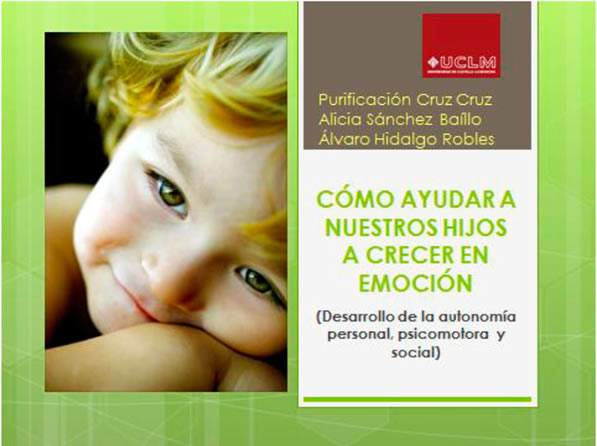
2.12. Objectives of the sessions
– Learn the meaning of the concept “emotional intelligence”
– Understand the importance of working emotional competence
– Recognize one’s own emotions and those of others
– Understand the global nature of the concept “motor development”
– Understand the gestational risk factors of certain neurodevelopmental disorders
– Understand the need to accompany and respect the stages of psychomotor development
– Understand the positive and negative repercussions of the “teaching” role of adults in the psychomotor process
– Facilitate practical activities to know how to face situations as fathers-mothers
– Participate in group activities
2.13. Development of the sessions
We have to start by saying that the process has been very rewarding for its results but terribly complicated at times. The contact with the health centers and their respective midwives was great and very generous, but the administrative processing through Nursing Management was delayed almost a month and all the documentation and information that would be taught in the workshop had to be reviewed (in spite of being supported and confirmed by the Faculty of Education of Toledo).
Once these procedures were completed, two workshops were held (one at the Medical Center of Buenavista, and one at the Medical Center of Palomarejos, Toledo), with the participation of 32 Members. But the talk has also been given to a group of nursing mothers (with babies) in the center of Palomarejos to be used as a control group. Although in this session there was only talk of emotional competence because the expert physiotherapy researcher was in a congress abroad.
At the beginning and after our presentation of the objective of this meeting, they were given a small questionnaire, with closed questions in order to have evidence of the contents and preconceived ideas with which they attend the workshop.
Picture 3. Image of the workshop
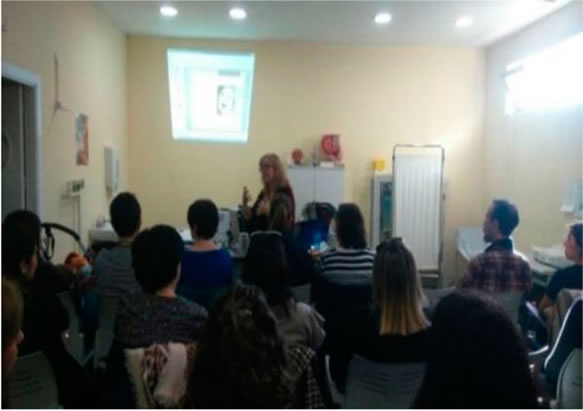
Picture 4. Image of the workshop
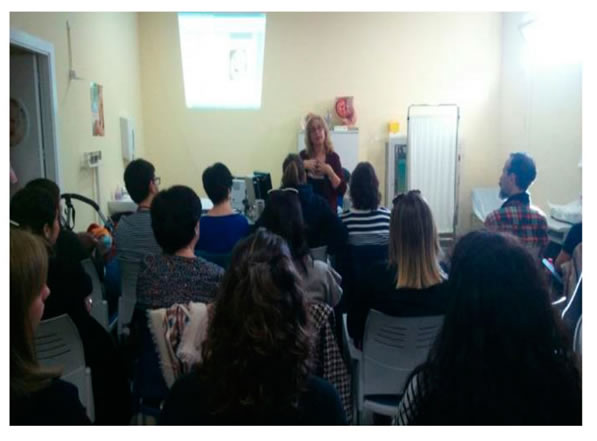
We used a PowerPoint presentation, with the objective that parents learned the meaning of the concept “emotional intelligence” and “psychomotor development” and understood the importance of having their children educated in this field. Trying to have the whole meeting seasoned with dialogue, exchange of experiences, solution of doubts, a little bit of humor and some tear contained with the excess of “hormonal and emotional jumble”. At the end of the session, we will give parents an information brochure, as a summary of the contents developed. All the information about the material used in the workshops is in: https://projectcapacities.wordpress.com/2017/01/19/escuela-prenatal-donde-esta-el-libro-de-instrucciones/
To conclude, we gave them another questionnaire, as a post-test, to verify the results, asking them to openly comment if they had found it interesting and what other topics they would like to work through the prenatal school for parents. Collecting their contributions and suggestions.
The three sessions were developed very satisfactorily, even their duration was much longer than agreed as, in the section of questions, doubts and suggestions, an atmosphere of dialogue, exchange of ideas and presentation of personal emotions was established.
Even in the first session, we were offered to give these workshops in private companies, specifically in a swimming school to work on these terms with the monitors and the dads and mothers of the children who attend the courses, and in the second session we were asked to impart these contents in the regional library of Castilla la Mancha, to an association of mothers in the old town of Toledo.
As an anecdote, also comment that a dad who attended the first workshop that took place in the medical center of Palomarejos, and that was alone, as his wife was working, attended again the same workshop, accompanied by his wife.
2.14. Result of the piece of research
Once the three workshops were completed, the data contributed by the participants through the semi-structured surveys was analyzed. Note that the sample is not very large (42) but the expectation to continue delivering these workshops and cover all pregnant couples, in the city of Toledo, is entirely feasible.
School for parents in the prenatal period
– Total number of attendees: 32. Number of fathers: 10. Number of mothers: 22
– Age range of the attendees: 30-44 years old and a grandmother
– Nº of new parents: 25. Parents with more children: 7
School for nursing parents
– Total number of attendees: 10. Number of fathers: 3. Number of mothers: 7
– Attendance age range of attendees: 32-46 years
– No. of new parents: 8. Parents with more children: 2
As you can see, the number of moms is much higher than the number of dads. It may be due to the fact that the workshop schedule was not the most adequate to make it compatible with working hours, but it was the one established by the health centers. We can also check how the age range in the first pregnancy is much higher than in previous years. But this parameter is not the object of study of this paper.
The fathers and mothers answered a total of 13 items, where they had to respond positively or negatively if they knew a series of aspects, concepts or ways of doing. The questioned items were:
1. Do you know what emotional intelligence is?
2. Do you consider the development of children’s self-esteem important?
3. Do you know how to respond to a tantrum?
4. Can overprotection cause school problems?
5. Should we educate our children so that they know how to mix with others?
6. Do you know how to do it?
7. Do you know what assertiveness is?
8. Do you know what badly learned behavior is?
9. Do you think that emotions are educated?
10. Do you know if, during pregnancy, it is possible to influence children’s motor development positively or negatively?
11. Would you say that the maturation of the Central Nervous System and a stimulating environment are at the same level of importance in child development?
12. Would you know how to guide and favor the motor development of your future child?
13. Do you know how alterations in motor development affect other areas of development?
In the graphs that we present below, we can observe the answers provided by the participants at the beginning of the session (answer that is represented in green if it is positive, that is, if they have previous knowledge about the worked contents and in red if they do not know the answer). You can see how dads and moms have general knowledge about what emotional intelligence is or how important it is in integral development, but they have many more doubts when asked about the practice, that is, about how they should act as parents in certain situations where emotions, their recognition and regulation of behavior influence. The same happens with psychomotor development, they know of its importance but they do not know the most appropriate way of acting to promote a good motor development of the baby.
Graphs of the pre-test and post-test responses
Table 1. Results of prenatal period pre-test
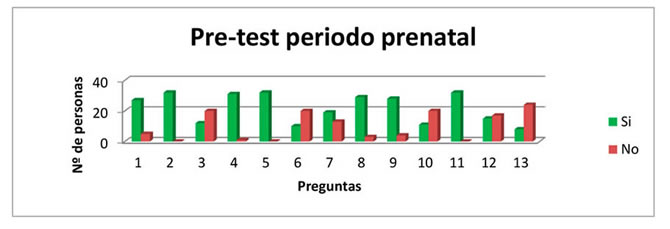
Once the session was over, they were asked to reply to the same items, logically the results varied enormously. We can say that it has no value because, during the session, the terms were explained, but we must not forget that the items that interested us the most were those that spoke about praxis, that is, the way of doing. It was not to understand a certain concept, it was to make the decision of whether they were prepared to carry out an action as a future father and mother. Therefore, the intervention, through the workshop, impacted on personal confidence and self-motivation of training in the role of educator. We want to highlight above all how the values of items 6, 10, 12 and 13 have changed.
Table 2. Results of prenatal period post-test

It is very gratifying to see, in Graph number 3, the positive results that the workshops have had, in addition to meeting a wonderful group of professionals and sharing very close “learning moments”.
Table 3. Number of people who have learned something new
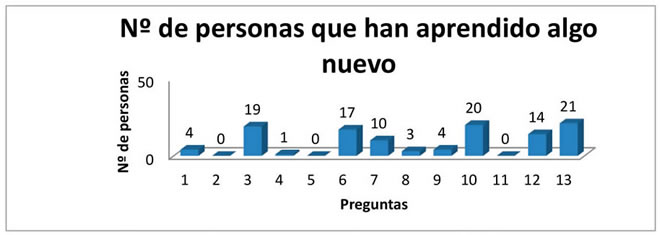
In the post-test they were also asked to indicate topics they would like to work on in this type of sessions of prenatal school for parents. These were their answers:
1. More knowledge about tantrums and how to treat them.
2. Distinguish when there is overprotection with our children.
3. Distinguish between need and whim.
4. Recommend children readings.
5. How to stimulate psychomotor development.
6. Know more about motivating environments.
7. Know more about portage.
8. Work on infant feeding contents.
9. Talk about language in the first years.
10. Expand the content on emotional intelligence.
We also offered them the opportunity to add some comments. In this space, we find numerous gestures of gratitude and request of our emails for future consultations. They also asked us to send them the presentation we used.
But let us not forget that the first and humble objective of this piece of research was to know if it
was possible to create a prenatal school for parents and if it was interesting for couples who were in this stage. To prove it, in the post-test they had to mark if the talk had seemed uninteresting, of little interest, quite interesting and very interesting. The overwhelming results can be checked in this graph. Obtaining 81% in the category of very interesting, along with 19% in the category of quite interesting.
Table 4. Interés por las sesiones formativas (prenatal)
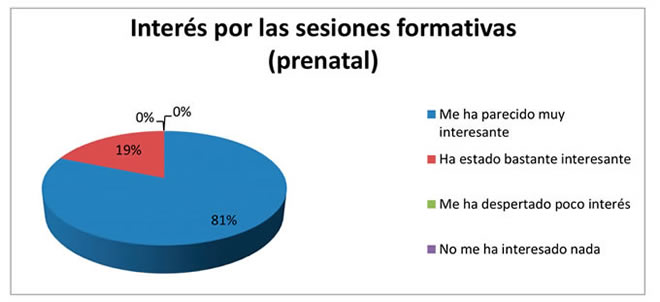
As we have mentioned before, we wanted to use a control group to verify the reliability of this piece of research, applying the same methodology to a group of mothers and fathers of children who are already born and who are breastfeeding. It was a very fun session surrounded by babies and very interesting as we could contrast the results, the different needs and the assessment of the workshop. We are left with a phrase from a mother at the end of the session “Why haven’t you come before? Now what do I do with my mistakes?”. To which we answered the following that remained as a motto: “The mistake is learning. It is mandatory to be wrong and more in the most difficult work in the world: to be a father and a mother.”
Table 5. Breast-feeding period pre-test
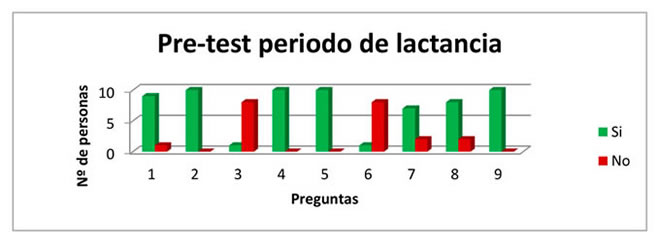
We can see, in the graphs, how the results are less conclusive than those provided by the prenatal stage group. Logically, the day-to-day experience in raising your baby brings knowledge and way of doing. But the differences are not very big and the results are still very positive when assessing the teaching process reached between the pre-test and the post-test. Especially in items 3 and in items 6. Items that correspond to the skills that must be applied in complicated situations. Situations in which parents are already beginning to live.
Table 6. Number of people who have learned something new
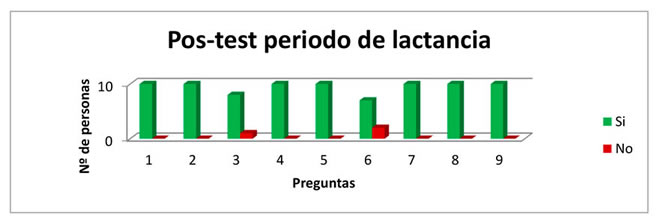

Table 7. Number of people who have learned something new
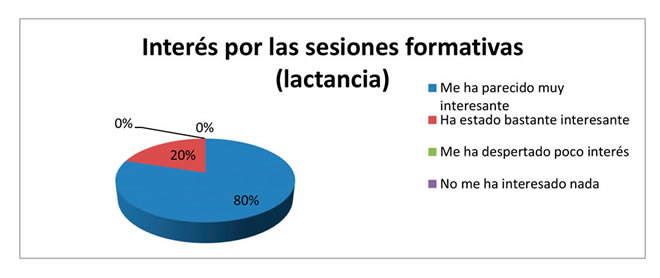
Their demand (since, in a session of an hour and a half, there is no time to deal with the subject in depth) is that we speak to, report to and train them in:
1. How to establish standards.
2. How to work positive reinforcement.
3. How to rectify misbehaviors.
4. The interpretation of emotions in babies.
5. Ways to behave with children.
6. How to treat tantrums.
7. More content about emotional intelligence.
8. Sleep in childhood.
9. How to work tolerance to frustration.
But what is really important, for our research, is the 80% response that considers this type of experience very important. They even demanded that we stayed another day, that the physiotherapist could go, to receive the notions of portering and infantile motor skills.
Table 8. Interest for the training sessions (lactation)
We are considering carrying out this type of workshops in the physical spaces of the Faculty of Education, in the Technological Campus of the Weapons Factory and having the help of children in the infantile grade to offer a daycare service during the workshops on school for parents.
3. CONCLUSIONS
All the professionals involved in this piece of research being together, we analyzed the objectives set:
Check the interest of this group to attend training sessions:
The workshops were carried out during the school holiday period, since it was the time when we were freed from our work as professors in the University or in the different educational centers where we work. It was a complicated date for families but still the attendance was the majority. The audience was complicated because some sessions were full of babies or mothers in a very advanced stage of pregnancy. But everything developed with absolute normality, in a very warm atmosphere and great reception by the participants. This is what we could verify from the participant observation. Secondly, we had a conversation with each of the midwives who expressed their gratitude for the experience carried out and how positive this type of meeting seemed to them. One of them commented that if we continued doing it at the University “we would fill the room”. And they encouraged us to continue working in this area. And finally, we must consider that, within the small sample we used, the results of the surveys show that the workshop has aroused a high level of interest among attendees.
Establish the prenatal time as the beginning of parent training:
It is the time of psychological preparation, of the preparation to change of life, of having long conversations to establish connections between the couple and make important decisions that will affect the life of the baby, it is the moment in which serenity is still mixed with a little of anxiety, before the “frustration accompanied by happiness” arrives (this is how a mother who already had another 2-year-old son defined it). Statistically, we can see how a 1% varies between prenatal parents and those who already have their baby, in terms of interest and need to treat these contents. Well, if it is the ideal moment, let us take advantage of that moment.
Start a process of interdisciplinary training, related to the prenatal stage:
It was achieved although with great administrative difficulties. It is logical to show uncertainty before an activity never carried out before and it is logical to control external agents who want to work in areas outside their competence. There have been many emails, many meetings, citations, etc. But the result has been worth it.
Start the methodology of school for parents in the prenatal group:
Statistically, we cannot prove it but we can say that our parents demand more information and training and that medical professionals do consider that it is a good time to create this figure of fathers and mothers participating in the educational process.
This experience has had important consequences, in addition to the results of the three workshops, because it has aroused interest, in the subject, at the Faculty of Education, in other professionals related to health, in other types of groups and associations that demand us that we continue working in the creation of this type of strategies. We wish the day had more than 24 hours and the week more than 7 days.
Those involved in this piece of research are considering, even, to present a proposal for action to the Ministry of Education of Castilla la Mancha. Since it is a subject yet to be addressed, researched and its importance to be recognized.
Is the prenatal time appropriate to start a school for fathers and mothers? The answer, after this wonderful experience, is flatly yes. It is the ideal moment because it is the most emotional moment, because we can learn before we err, because the family is the main educating agent, because, as Pestalozzi would say, “true learning takes place with the head, the heart and the hands”
REFERENCES
1. American Academy of Pediatrics. (2001). Committee on Injury and Poison Prevention. Injuries associated with infant walkers, 108, 790-2.
2. Asonitou, K., Koutsouki, D., Kourtessis, T., & Charitou, S. (2012). Motor and cognitive performance differences between children with and without developmental coordination disorder (DCD). Research in developmental disabilities, 33(4), 996-1005.
3. Brunet, J.J. y Negro, J.L. (1985). ¿Cómo organizar una escuela de padres? Madrid: Ediciones San Pío X.
4. Escuela de padres (2010). Como surge la escuela de padres. Buenas tareas. Recuperado de http://www.buenastareas.com/ensayos/Esuela-Para-Padres/5780331.html
5. Fresnilllo, V., Fresnillo, R. & Fresnillo, M.L. (2010). Escuela de padres. Disponible en http://orientacionandujar.files.wordpress.com/2009/05/escuela-de padres.pdf
6. Gesell, A. (1939). Reciprocal interweaving in neuromotor development. A principle of spiral organization shown in the patterning of infant behavior. The Journal of Comparative Neurology, 70(2), 161-80
7. Goleman, D. (1995). Inteligencia emocional. Barelona: Kairós.
8. Grace, T., Bulsara, M., Robinson, M. & Hands, B. (2016). The Impact of Maternal Gestational Stress on Motor Development in Late Childhood and Adolescence: A Longitudinal Study. Child Development, 87(1), 211-220.
9. Hurtado, M.; Cuadrado, S. y De la Herrán, A. (2015). ¿Hacia una pedagogía prenatal. Revista Ibero-Americana de Educación, 67(1), 151-168. Disponible en https://www.uam.es/personal_pdi/fprofesorado/agustind/textos/PedagogiaPrenatal1.pdf
10. Ibarrola, B. (2009). Crecer con emoción. El desarrollo de la competencia emocional en Educación infantil. Madrid: SM.
11. Jarque, J. (2013). Folletos para familias. Familia y cole. Recuperado de http://jesusjarque.com/
12. Macias, L., y Fagoaga, J. (2002). Fisioterapia en Pediatría. Madrid, España: McGraw-Hill/ Interamericana de España.
13. Murin, S., Rafii, R., & Bilello, K. (2011). Smoking and smoking cessation in pregnancy. Clinics in Chest Medicine, 32(1), 75-91.
14. Müürsepp, I., Aibast, H., Gapeyeva, H., & Pääsuke, M. (2014). Sensorimotor function in preschool-aged children with expressive language disorder. Research in developmental disabilities, 35(6), 1237-1243.
15. Naranjo, J.M. (2009). Qué es una escuela de padres. Recuperado de http://www.contreras.nom.es/Colegio/Escuela_Padres/1_Que-es-una-escuela-de-padres.htm
16. Ortiz, F. (2010). Qué es, para qué sirve y cómo funciona de forma virtual. Escuela para padres. Recuperado de http://blog.micumbre.com/2010/01/26/escuela-para-padres-que-es-para-que-sirve-y-como-funciona-de-forma-virtual/
17. Pikler, E. (2014). Moverse en libertad: Desarrollo de la motricidad global. Madrid: Narcea.
18. Redle, E., Vannest, J., Maloney, T., Tsevat, R.K., Eikenberry, S., Lewis, B., Shriberg L.D., Tkach, J., & Holland, S.K. (2015). Functional MRI evidence for fine motor praxis dysfunction in children with persistent speech disorders. Brain research, 1597, 47-56.
19. Romero, A. (2002). Guía para asesorar sobre el funcionamiento de las asociaciones de madres y padres (AMPA). Albacete: Consejería de Educación de Castilla la Mancha
20. Romo, A., Carceller, R., & Tobajas, J. (2009).Intrauterine growth retardation (IUGR): epidemiology and etiology. Pediatric Endocrinology Reviews, 6(3), 332-6.
21. Santos, L., Paricio, J.M., Salom, A., Grieco, M., Martín, J., Benlloch, M.J., Llobat, T., & Beseler, B. (1996). Patterns of use, popular beliefs and proneness to accidents of a baby walker (go-cart): Bases for a health information campaign. Anuario Español de Pediatría, 44, 337-40.
22. Trujillo, J.J. (2012) Las Escuelas de Padres; más allá del enfoque transmisivo. Odiseo. Revista electrónica de Pedagogía. Disponible en http://odiseo.com.mx/bitacora-educativa/2012/01/escuelas-padres-mas-alla-del-enfoque-transmisivo
AUTHORS
Purificación Cruz Cruz
Infantile Education Teacher for more than 27 years at Our Lady of Infants School. Psychopedagogue. Doctor of Infantile and Family Education. Professor at the Faculty of Education of the University of Castilla la Mancha, Toledo. Lecturer in several associations of parents and groups of teachers. Author of several books and articles on education and emotional intelligence. https://orcid.org/0000-0001-5637-3007
Álvaro Hidalgo Robles
Physiotherapist graduated from the University of Castilla-La Mancha (UCLM) in 2016. Physiotherapist at St Juan de Dios Center for Special Education – APACE Toledo. Partner of the Spanish Society of Physiotherapy in Pediatrics (SEFIP) and collaborator in Disability, Inclusion and Citizenship (UCLM) and diverse continuous training related to infantile physiotherapy.
https://orcid.org/0000-0001-6294-7476.
Alicia Sánchez Baillo
Infantile Education Teacher, UCLM, Toledo. Work experience: Non-ruled language teaching professor. Open Classroom Educational Management; Camp monitor, Open Classroom SL Educational Management; Professor of private English lessons, Toledo.